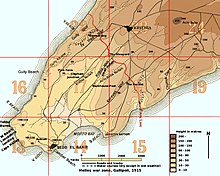
Gully Ravine is a 4 km long ancient water course on the north side the Gallipoli Peninsula in Western Turkey. The ravine runs down in a south westward direction to the sea from the foothills of Achi Baba, an area of high ground which was, very optimistically, the objective of the allied forces for 26 April 1915, the day after the landings at the beaches on the western end of the peninsula. Achi Baba was never taken by the Allies. There are a number of ravines that run westward towards the sea in this way, but most are just a few metres deep. Thousands of years of erosion have made Gully Ravine up to 30 metres deep in places.
Allied attacks on the spurs to the west and east of the ravine and the resulting trench systems made the gully an essential access route for the front lines, and also itself the scene of direct and bitter fighting. The final allied front line prior to evacuation was approximately 2/3 of the way up the ravine. Another feature that made Gully Ravine such a focus of activity is that it is far more than simply a sunken stream bed. Smaller gullies and openings run off it on either side, and these were quickly pressed into use as dressing stations, supply dumps, dormitories, practice firing ranges and stables etc.
The gully is a microcosm of all that trench warfare was - both in terms of the fighting and death, the stalemate of attack and retreat, and also the building - in truly awful circumstances, of a 'home from home'. It is also a relatively unknown part of the Gallipoli campaign. Thousands visit the Anzac areas and the British landing beaches such as V, W and X, but the deeper parts of Gully Ravine lie unfrequented, except for a few with specialist, or personal, interest.
References / notes
- Information: Andy Crooks, 2008.
Glossary of words and phrases
The above term is listed in our glossary of words and phrases of the Armed Forces of Great Britain during the Great War. Included are trench slang, service terms, expressions in everyday use, nicknames, the titles and origins of British and Commonwealth Regiments, and warfare in general. These words and phrases are contemporary to the war, which is reflected in the language used. They have been transcribed from three primary sources (see Contents). Feel free to expand upon and improve this content.
Browse other terms: A B C D E F G H I J K L M N O P Q R S T U V W X Y Z
